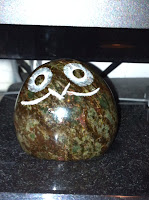In the least-known part of Scotland, the acute-angled bit
jutting out north of Aberdeen, is the area called Banffshire. Officially, now,
this is all part of Aberdeenshire, but it is still known colloquially as
Banffshire, the area surrounding the solid, sturdy little town of Banff. Drive
westwards along the main road out of Banff and you will, after a few miles,
arrive at Portsoy.
Portsoy is typical of the many fishing villages
strung out at regular intervals along the entire Moray and north Aberdeenshire
coastline, and is just as typically untouched and unspoiled. It boasts a
charming seventeenth century harbour which—outwith the rather more modern boats, and the car tyres providing buffers to prevent boats running into the harbour
walls—must have looked almost identical three hundred years ago to how it looks
today. Flanking the harbour is a number of buildings of similar
age, which would have been used for storage, chandlery, workshops and the like. In one of these
can now be found a shop called Portsoy Marble.
One of Portsoy’s chief “claims to fame” is that it is the only
place where the stone which is now known as Portsoy marble can be found. Portsoy marble (actually not marble
but a form of Serpentine) comes in a range of hues, from turquoise,
through sea green/grey, to a deep chocolate brown and oxide red.
Every piece is
different, and the seam itself was long ago exhausted, a good proportion of it having
been used in the Palace of Versailles. Today what remains is only those pieces that are found along the beach. In Portsoy Marble, alongside many gems and fossils,
one can still buy pieces made from the rare and attractive stone which gives the shop its name…but not for
much longer, it seems.
I have been visiting Portsoy for the past five years on my
annual pilgrimage to this most beautiful of areas, and on my visit last year
heard the sad news that the old gentleman responsible for working the stone
into paperweights, eggs, key fobs, “Fyvie balls” and charming little owls, had
just died. On this year's visit, the pieces of Portsoy marble available had
dwindled to a handful of smooth, randomly shaped paperweights, a couple of key fobs, and one solitary
egg (which I bought). I talked to the owner about the situation and at the
present time he isn’t sure whether or not there will be any more pieces once
the present ones have gone.
For many years the old gentleman worked in his workshop next
to the shop, producing the balls, eggs, owls and other pieces. In that one
single man was invested a lifetime of experience and skill, which allowed him
to produce such items with great dexterity and sureness of touch. The problem now
confronting the owner is twofold: firstly, he has no one to teach him the
skills, and secondly he cannot afford the huge commitment of time and effort required to
attain them. In these days where everything must be costed and accounted for,
it is simply impossible for him to produce saleable pieces without wasting more stone than he uses and without it taking far too long to be worth his while.
And so, it seems, the three or four owls I bought last year,
and the egg I managed to obtain this year, may be amongst the last pieces of
Portsoy marble sold. Unless the owner has a change of heart, or unless he can
find someone who already has stoneworking skills necessary to produce new
pieces economically, that will be the case.
There is much to be said for economies of scale,
rationalizing of costs, efficiency savings and the rest. There is no doubt that
these are the engines of affordability and were it not for our major businesses
and corporations continuing to pursue these rainbow-terminating pots of gold,
much of the consumer goods we enjoy today would be beyond our budget. But there
is something unbearably sad about watching such manual skills passing out of
existence, about bearing witness to a craft passing from the present into
the past with, apparently, nothing to prevent it happening.
No blame for this attaches to the owner of the shop, of
course; he must make a living the same as the rest of us, and if it took him
all week to make one little owl, no one could afford to pay for it a price
sufficient to cover his costs and give him a reasonable profit for his efforts.
But we must guard and cherish such skills as still remain and do more to ensure
they continue.
Picking up one of the few pieces of Portsoy
marble I am fortunate enough to own, I can feel the way they must have been
held in the rough, calloused, skillful fingers of their maker, as he turned them
around and around in his hand, working, sanding, smoothing, checking for imperfections
with an experienced eye and refined touch until he was satisfied with the
piece. I was never lucky enough to meet him, but I imagine him to have given a
gruff grunt of approval at each one he finished. These are qualities intangible
within the stone; you could cut the stone into smaller and smaller pebbles
without finding them, yet they are no less real for it. Embedded within each
piece is the time, care and love invested in them by their creator. And something
similar can be found in every pot, toy, piece of furniture or jewellery made in
a similar way. These are qualities far, far beyond mere pounds and pence.






